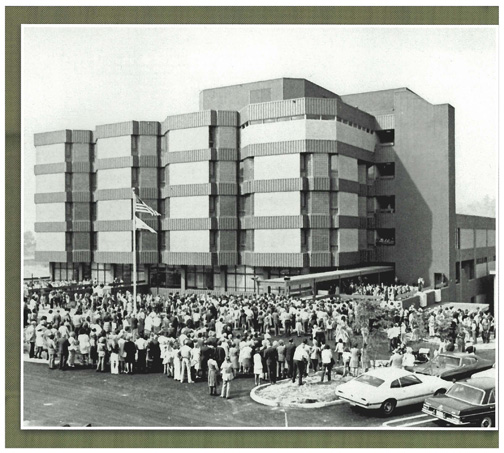
In the late 1960s, the neighborhoods at the base of the Verdugo Mountains were quiet and rustic and a lot more isolated from the rest of Los Angeles. Neither the 2 nor the 210 freeways had been built and so getting in and out of the area was a far more difficult task than it is today. The nearest full-service hospital at the time was in Glendale, which was too far for comfort in the event of an emergency. This led community leaders and local physicians to lobby for a neighborhood hospital.
A proposal surfaced to repurpose and relocate the small existing Behrens Memorial Hospital that had long-term viability issues due to new California State Dept. of Health codes and no room for expansion. The plan was developed by Behrens’ physicians and community leaders to create a true, community-based hospital – with a name that reflected the communities it would serve – Verdugo Hills Hospital. J. Morgan Greene and his family donated land for the construction of the new hospital on a hillside where the cities of La Cañada Flintridge and La Crescenta meet the Verdugo Mountains.
When it opened in 1972, Verdugo Hills Hospital was a victory for the community that lobbied so hard to have it built. It became a model community hospital where doctors and staff developed relationships with the patients they treated and their families.
By the early 2000s, however, Verdugo Hills Hospital experienced the financial challenges of being an independent hospital not affiliated with a larger health system.
“With the merger between Keck Medicine of USC and Verdugo Hills Hospital in 2013, huge investments were made in restoring and revitalizing the important health care resources that this community had come to rely on,” said Armand Dorian, MD, MMM, CEO of USC-VHH.
The hospital now has a Neonatal Intensive Care Unit, an Interventional Radiology and Cardiac Catheterization Lab, an award-winning Emergency Dept., a nationally-ranked Urology Dept. (via Keck Medicine of USC) and a robust women’s health practice. It is also a center of excellence for knee and hip replacement and physical medicine.
One thing that has not changed is the personal touch and the comfort of receiving care in a smaller, more intimate hospital.
“We still wanted to provide the personalized care to the patients that we serve in this community and I think we have kept that,” said Happy Khanna, MD, chief of staff at USC-VHH. “Our patients are always very satisfied.”
Looking forward to the next 50 years, the staff at USC-VHH believes it will continue to provide the foothill communities with even better health care. Through the affiliation with Keck Medicine, there is more opportunity to provide personalized, multidisciplinary care that is the hallmark of health care in the future.
“We are set up to be leaders in regard to how health care is provided going into the next century,” said Paul Gilbert, MD, orthopedic surgeon.
